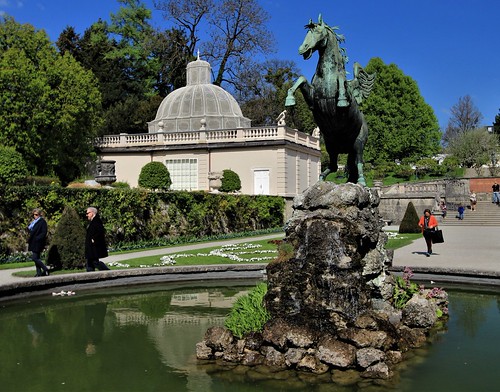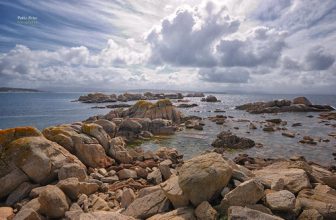

Mirabell Palace in Salzburg’s Right Old Town in Austria is one of the most popular tourist destinations in the city due to its history, the famous baroque staircases created by Georg Raphael Donner , and its gardens.
The entire complex with all outbuildings and horticultural monuments is a listed building and is part of the UNESCO World Heritage Site (see also Historical Center of the City of Salzburg ). The interiors are largely used by the Salzburg city administration; The state hall ( Marble Hall ) serves as a concert and wedding hall and is often used by international guests.
Mirabell Palace, now located in the Neustadt of the city of Salzburg, was built around 1606 by Archbishop Wolf Dietrich von Raitenau outside the then city walls for the archbishop’s lover or secret wife, Salome Alt, and was initially called Altenau Palace . It was "a beautiful, large, quartered, magnificent building, like a castle or fortress, with a cloud-covered, gleaming tower covered with Plech and decorated and furnished inside and outside with beautiful gardens of all sorts of flowers, plants and fruits." Remains of this building have been preserved in the southwest corner of the current building in the basement. The sovereign, who was always caring for his family, obtained legitimacy from the emperor as legal heirs for his 15 children, and elevation to the hereditary nobility for his children and loved ones. Mother and children now called themselves Alt von Altenau . However, that was of little use later. After Wolf Dietrich’s fall and solitary confinement at Hohensalzburg Fortress in 1612, his successor and nephew Markus Sittikus von Hohenems soon expelled his wife and children from Altenau Castle. In order to completely erase the memory of his predecessor, Markus Sittikus now called the castle Mirabell . Mirabell is a female first name from Italian ( mirabile ‘admirable’ and bella ‘beautiful’).
During the Thirty Years’ War between 1620 and 1642, Prince Archbishop Paris von Lodron had Mirabell Palace and its gardens included in the new, strong fortification belt on the right bank of the Salzach. In contrast to Markus Sittikus, he enjoyed living in the castle and also died here.
From 1721 to 1727, on behalf of Archbishop Franz Anton von Harrach, the well-known baroque builder Johann Lucas von Hildebrandt converted it into a magnificent baroque palace complex, a four-wing complex with an inner courtyard, which, after tough discussions, is no longer used as a parking lot. In 1818, a devastating city fire caused extensive damage. The reconstruction was carried out on behalf of Emperor Franz I , who himself gave precise instructions for it. However , the concept of court building officer Peter Nobile was too expensive for the emperor, which is why he commissioned the Salzburg district engineer Johann Wolfgang Hagenauer to plan and carry out the construction. As a result, the building lost much of its former unique baroque appearance. The mighty tower in the middle of the east facade was demolished, the delicate gable structure with the slightly projecting corner projections on the east side disappeared, as did the roof ledges richly decorated with numerous vases and 28 figures. Fortunately, the western courtyard façade and the garden façade to the west were largely preserved. The rhythm of sculpturally protruding risalits and well-structured wall surfaces convey an idea of the original appearance of the baroque masterpiece, although the former artistic roof top and figures are also missing here.
From 1810 to 1816 under Bavarian rule, Mirabell Palace was the residence of the Bavarian Crown Prince. Prince Otto of Bavaria , later King Otto I of Greece, was born in the castle on June 1, 1815 .
The father of the Salzburg painter Hans Makart also worked here as a room attendant before 1849. Archbishop Cardinal Maximilian Joseph of Tarnóczy resided in this castle from 1851 to 1863 . The aged Capuchin priest and Tyrolean freedom hero Joachim Haspinger († 1858) spent the last four years of his life here in a ground floor apartment.
In 1866 the castle, together with the Kapuzinerberg, became the property of the city of Salzburg for compensation of 50,000 guilders. The emperor had donated the Mirabell Gardens to the city two years earlier. Between 1947 and 1950, the official residences of the mayor and his deputies, as well as the municipal administration and some municipal departments, were set up here.
Mirabell Castle Church
The Georg-Raphael-Donner staircase is a magnificent staircase that extends from the ground floor to the second floor and is located in the north corner of the west wing. The balustrade of the staircase is richly intricate and decorated with various putti, which can be seen in a variety of postures, sitting, lying and playing. There are niches set into the walls containing mythologically inspired marble sculptures. There are antique busts above the doors.
The Marble Hall is clad in marble, imitation marble and gilded stucco. In between there are decorative stucco fields. The former large ceiling painting by Johann Michael Rottmayr was lost in the fire in 1818. Because of its ambience and very good acoustics, the hall is now used for weddings and classical concerts. As part of the Salzburg Palace Concerts under the musical direction of Luz Leskowitz , and from 2016 under the direction of Konstantin Hiller, well-known ensembles such as the Salzburg Soloists, the Bartók Quartet and the Twins Quartet as well as famous soloists such as Jörg Demus and Igor Oistrach perform.
Before the fire of 1818, the castle chapel (the church of the Old Catholics since 1938) had a ceiling painting by Bartolomeo Altomonte and is dedicated to Saint Nepomuk . Severely damaged in the fire, it was re-inaugurated in 1837 by Archbishop Friedrich Johann Jacob Cölestin von Schwarzenberg . The altar with its sculptures of Augustine, Rupert, Virgil and Martin essentially dates from 1722. The altarpiece of Saint Nepomuk, which was destroyed in the fire, was recreated and inserted by Johann Michael Hess in 1830. The castle church has been a parish church of the Old Catholic Church of Austria since July 1938 ; previously the services took place in the Marble Hall. The small church was renovated in 1952 and 1988. The Old Catholic Church in Mirabell Palace takes part in the ecumenical Long Night of the Churches every year . Since 2012, classical music concerts have also taken place in the church at regular intervals.
In addition to parts that have been built up today (e.g. by the Mozarteum University ), the palace’s gardens include the large parterre , the hedge theater , the water bastion , the rose garden and the original dwarf garden , as well as the spa garden in place of the demolished old Mirabell bastion .
The gardens were largely preserved when the castle burned. In today’s complex, it was largely designed by Johann Bernhard Fischer von Erlach and was modified by Anton Danreiter around 1730 .
The orangery with the adjacent palm house as a greenhouse was built around 1725. The Salzburg Baroque Museum has been located south of it since 1973 .
The small, elongated hedge theater with its symmetrical paths surrounded by cut trees and its central open spaces was built between 1704 and 1718 on the Lodron defensive wall. It is still occasionally used today for small theater performances or concerts.
The historic baroque dwarf garden south of the raised water bastion – i.e. in front of the fortifications – was transformed into an English garden around 1800, which has long since been preserved. Old plans document its original condition. There were originally 28 grotesque marble gnomes in the garden, created in 1690/91 as part of the baroque redesign by Johann Bernhard Fischer von Erlach and Johann Ernst Graf Thun. They were sold in 1811 and could no longer be completely assembled; they were then temporarily placed on the small, preserved Lodron water bastion. The restoration of the original baroque garden. as part of Fischer von Erlach’s total work of art remains an important concern.
Posted by [email protected] on 2022-09-28 18:35:30
Tagged: , mirabell-palace , schloss-mirabell , salzburg , austria , Österreich , central europe , europe , EU , european union , european area , european country , schengen , schengen area , schengen country , Republik Österreich-German , Eastern alps region , Ausztria , Közép-Európa , Európa , Európai Unió , európai övezet , európai ország , schengeni , schengeni övezet , schengeni ország , Republik Österreich-Német , Keleti-Alpok régió , Avstrija , srednja evropa , evropa , evropska unija , evropsko območje , evropska država , schengensko območje , schengenska država , Republik Österreich-Nemčija , regija vzhodnih alp , Austrija , središnja europa , europa , europska unija , europsko područje , europska država , schengensko područje , Republik Österreich-njemačka , regija istočnih alpa , #VisitAustria , #AustriaTravel , #AustrianCulture , #AustriaTourism , #DiscoverAustria , #AustrianHeritage , #ExploreAustria , #AustriaAdventure , #AustriaPhotography , #AustriaLove , #AustriaTrip , #AustrianHistory , #AustriaHighlights , #AustriaTravelGuide , #AustriaExperience , #AustriaHoliday , #CulturalAustria , #BeautifulAustria , #KnowAustria , #HistoricalAustria






